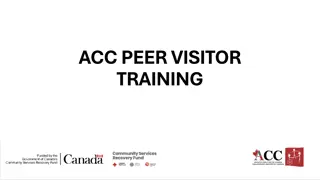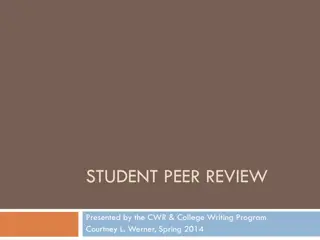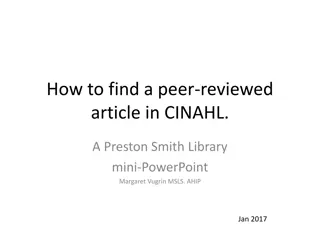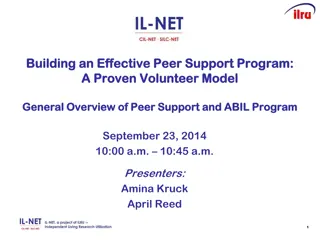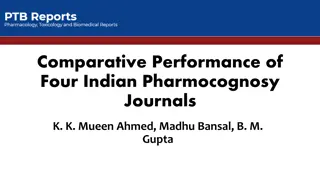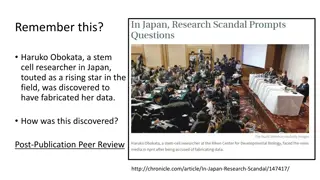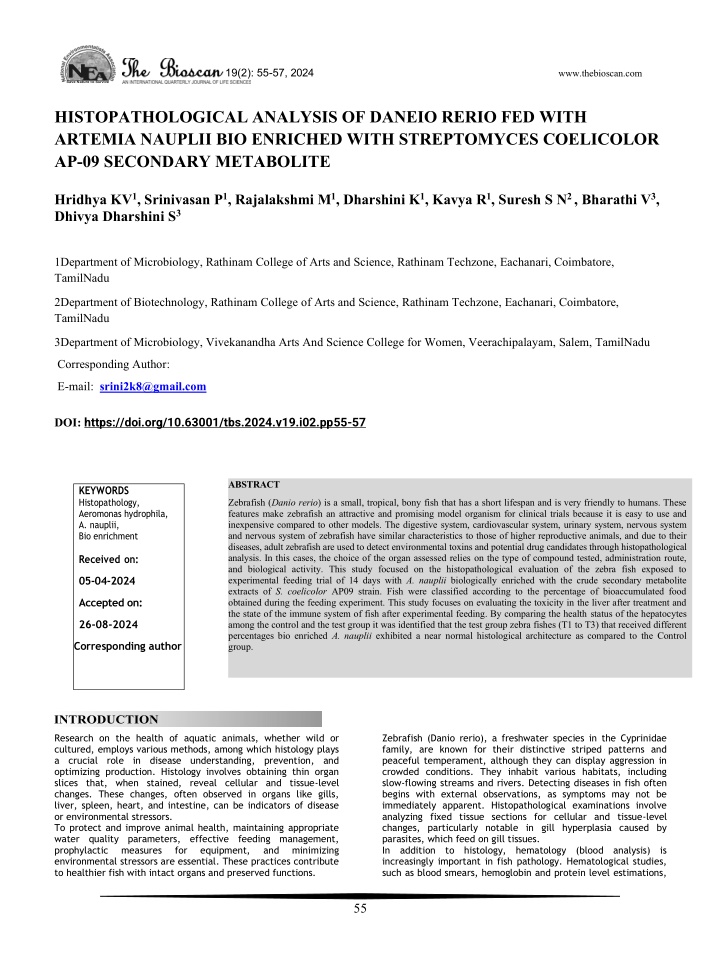
peer reviewed scientific journals
Peer-reviewed scientific journals are academic publications that feature articles which have undergone a rigorous evaluation process by experts in the field before being published. This process typically involves Submission: Authors submit their rese
Download Presentation

Please find below an Image/Link to download the presentation.
The content on the website is provided AS IS for your information and personal use only. It may not be sold, licensed, or shared on other websites without obtaining consent from the author. If you encounter any issues during the download, it is possible that the publisher has removed the file from their server.
You are allowed to download the files provided on this website for personal or commercial use, subject to the condition that they are used lawfully. All files are the property of their respective owners.
The content on the website is provided AS IS for your information and personal use only. It may not be sold, licensed, or shared on other websites without obtaining consent from the author.
E N D
Presentation Transcript
N Save Nature to Survive 19(2): 55-57, 2024 www.thebioscan.com HISTOPATHOLOGICAL ANALYSIS OF DANEIO RERIO FED WITH ARTEMIA NAUPLII BIO ENRICHED WITH STREPTOMYCES COELICOLOR AP-09 SECONDARY METABOLITE Hridhya KV1, Srinivasan P1, Rajalakshmi M1, Dharshini K1, Kavya R1, Suresh S N2 , Bharathi V3, Dhivya Dharshini S3 1Department of Microbiology, Rathinam College of Arts and Science, Rathinam Techzone, Eachanari, Coimbatore, TamilNadu 2Department of Biotechnology, Rathinam College of Arts and Science, Rathinam Techzone, Eachanari, Coimbatore, TamilNadu 3Department of Microbiology, Vivekanandha Arts And Science College for Women, Veerachipalayam, Salem, TamilNadu Corresponding Author: E-mail: srini2k8@gmail.com DOI: https://doi.org/10.63001/tbs.2024.v19.i02.pp55-57 ABSTRACT KEYWORDS Histopathology, Aeromonas hydrophila, A. nauplii, Bio enrichment Receivedon: Zebrafish (Danio rerio) is a small, tropical, bony fish that has a short lifespan and is very friendly to humans. These features make zebrafish an attractive and promising model organism for clinical trials because it is easy to use and inexpensive compared to other models. The digestive system, cardiovascular system, urinary system, nervous system and nervous system of zebrafish have similar characteristics to those of higher reproductive animals, and due to their diseases, adult zebrafish are used to detect environmental toxins and potential drug candidates through histopathological analysis. In this cases, the choice of the organ assessed relies on the type of compound tested, administration route, and biological activity. This study focused on the histopathological evaluation of the zebra fish exposed to experimental feeding trial of 14 days with A. nauplii biologically enriched with the crude secondary metabolite extracts of S. coelicolor AP09 strain. Fish were classified according to the percentage of bioaccumulated food obtained during the feeding experiment. This study focuses on evaluating the toxicity in the liver after treatment and the state of the immune system of fish after experimental feeding. By comparing the health status of the hepatocytes among the control and the test group it was identified that the test group zebra fishes (T1 to T3) that received different percentages bio enriched A. nauplii exhibited a near normal histological architecture as compared to the Control group. 05-04-2024 Accepted on: 26-08-2024 Corresponding author INTRODUCTION Research on the health of aquatic animals, whether wild or cultured, employs various methods, among which histology plays a crucial role in disease understanding, prevention, and optimizing production. Histology involves obtaining thin organ slices that, when stained, reveal cellular and tissue-level changes. These changes, often observed in organs like gills, liver, spleen, heart, and intestine, can be indicators of disease or environmental stressors. To protect and improve animal health, maintaining appropriate water quality parameters, effective feeding management, prophylactic measures for environmental stressors are essential. These practices contribute to healthier fish with intact organs and preserved functions. Zebrafish (Danio rerio), a freshwater species in the Cyprinidae family, are known for their distinctive striped patterns and peaceful temperament, although they can display aggression in crowded conditions. They inhabit various habitats, including slow-flowing streams and rivers. Detecting diseases in fish often begins with external observations, as symptoms may not be immediately apparent. Histopathological examinations involve analyzing fixed tissue sections for cellular and tissue-level changes, particularly notable in gill hyperplasia caused by parasites, which feed on gill tissues. In addition to histology, hematology (blood analysis) is increasingly important in fish pathology. Hematological studies, such as blood smears, hemoglobin and protein level estimations, equipment, and minimizing 55
and biochemical tests, reveal changes associated with infections, feeding patterns, and environmental conditions. Actinomycetes, particularly Streptomyces species, are significant sources of antibiotics, with approximately 9500 reported antibiotics originating from this group. However, the discovery of new antibiotic compounds has declined in recent decades, emphasizing the need to explore novel organisms and environments to combat emerging Integrating histological and hematological techniques is crucial for understanding and managing the health of aquatic animals. This multidisciplinary approach aids researchers and fish farmers in disease diagnosis, prevention, and maintaining optimal aquaculture conditions. MATERIALS AND METHODS 1. Experimental Setup for Hatching Artemia nauplii (Nimisha P and Sheeba S, 2013): An Artemia hatching container was made by using a non-leaking bottle by providing appropriate growth conditions (aeration, hatching media with water of 35PPM salinity, rock salt), incubation done by using focus lamps. 2. Bio-enrichment of Artemia nauplii with Actinomycete AP- 9 isolate secondary metabolites A. nauplii II instar (12 h old) larvae were selected and sieved by using 120 m sieve and transferred into glass enrichment container (~ 200 nauplii/ ml) each having 100 ml salt water incorporated with microbial secondary metabolites (10 ml with basal feed un enriched nauplii, and 1.5, 3 and 6 mg/ml secondary metabolite enriched nauplii) corresponding to groups RESULTS AND DISCUSSION as follows T0 Fish fed with un enriched nauplii (Control group) T1 Fish fed with 1.5% bio enriched nauplii (Test group 1) T2 Fish fed with 3.0 % bio enriched nauplii (Test group 2) T3 Fish fed with 6.0 % bio enriched nauplii (Test group 3) The container was incubated at 28 to 30 for 12 h with strong aeration. After enrichment the nauplii were collected and observed under light microscope (Nikon Eclipse MV200 Microscope, Courtesy-BU-DRDO) 3. Experimental feeding trial of Zebra fish using enriched nauplii D. rerio fish fry (n = 10) were transferred into experimental tank containing 3 L of freshwater and were fed with 4 nauplii (12 h enriched and control nauplii)/fry for two times a day. Experimental trial was conducted for 14 days. Exposure of control feed fed and test feed fed fish to 0.1% A. hydrophila. 4.Histopathological studies D. rerio (n=2) were subjected to A. hydrophila exposure for 18 hours via immersion method. The fishes where then subject to histopathological studies. The organ samples (liver) were removed and fixed in 10% neutral buffered formalin, embedded in paraffin wax and stained with hematoxylin and eosin (0.5% v/v) for optical examination. Micrograph of the organs were taken from the paraffin sections at a final magnification of 200 using a Nikon Eclipse E-200 microscope. For each group, micrographs originating from two fishes (n = 2) were analysed (Kaleeswaran et al., 2012). diseases effectively. the hepatocytes, with narrowed Hepatic vein, Inflammatory cells aggregation (melano machrophage), Karyomegaly, Karyolysis, Hepatic focal necrosis (inset), and irregular hepatocellular arrangements were less pronounced in the test group and showed near normal appearance as compared to the pathogen exposed T0- Control group. CONCLUSION Histopathological analysis Figure 2. Light micrograph ( 200) of Liver of Danieo rerio (T0 to T3) 14 days batch. Aeromonas hydrophila exposed fish liver shows degeneration in the hepatocytes, with narrowed Hepatic vein, Inflammatory cells aggregation (melano machrophage), Karyomegaly, Karyolysis, Hepatic focal necrosis (inset), and irregular hepatocellular arrangements. Further the experimental groups showed near normal appearances after pathogen exposure. (HVHepatic Vein; HC- Hepatocyte; IC-Inflammatory cells; KMKaryomegaly; KL- Karyolysis; HFN- (Hepatic Focal Necrosis). (Acknowledgement-CMFRI, Kochi) The current study assessed the status of the Zebra fish internal organ -Liver after the experimental feeding trial for 14 days with the microbial secondary metabolite biologically enriched A.nauplii diet. However, the present study incorporated only the crude extract of the secondary metabolite for the bio enrichment and feeding trials. Further studies are required on the partial purification of the active principles in S.coelicolor AP09 secondary metabolite in order to narrow down the effective compound responsible for enhancing the disease resistance against the pathogen infection. ACKNOWLEDGEMENT This project is the outcome of research work carried out in the Department of Microbiology under the DBT Star College Scheme. The authors are grateful to the Department of Biotechnology (DBT), Ministry of Science and Technology, Govt. of India, New Delhi, and the Department of Microbiology for the support The results of the histopathological study revealed the following phenomenon: The S. coelicolor AP09 secondary metabolite enriched Artemia nauplii diet to the D. rerio fish did not result in significant acute toxicity as compared to the control group after the experimental feeding trial and there were no mortalities. When all the experimental fish groups were exposed to A. hydrophila exposure, it was observed that their immune response and the damage to the hepatocellular architecture was significantly less in the Test groups (i.e., T1, T2, and T3) while it was as compared to the basal feed fed control group T0. Notably the histopathology results of the T3 group hepatic portal vein revealed the neutrophil intrusion which elucidated a single point active immune function of the WBCs against the pathogen which was less pronounced in other groups. Further, the findings suggest that symptoms like degeneration in 1. 2. 3. 56
REFERENCES Alestr m P, Holter JL, & Nourizadeh-Lillabadi R (2006). Zebrafish in functional biomedicine. Trends in biotechnology, 24, 15 21.doi:10.1016/j.tibtech.2005.11.004. Borges AC, Pereira N, Franco M, Vale L, Pereira M, Cunha MV, Rebelo M (2016). Implementation of a zebrafish health program in a research facility: a 4- year retrospective study. Zebrafish, 13, S115 S126. doi:10.1089/zeb.2015.1230. Michael ET, Amos SO, Hussaini LT. A review on probiotics application in aquaculture. Fisheries and Aquaculture Journal. 2014; 5(4): 111. Subasinghe R, Soto D, Jia J (2009) Global aquaculture and its role in sustainable development. Reviews in Aquaculture 1: 2-9 Snieszko SF (1974) The effects of environmental stress on the outbreaks of infectious diseases of fish. Journal of Fish Biology 6:197-208 Selvameenal L, Radhakrishnan M, Balagurunathan R. Antibiotic pigment from desert soil Actinomycetes; biological activity, purification screening. Indian J Pharm Sci. 2009; 71:499 504. Kaleeswaran, B., S. Ilavenil and S. Ravikumar, 2012. Changes in biochemical, histological and specific immune parameters in Catla catla (Ham.) by Cynodon dactylon (L.). J. King. Saud Univ.Sci., 24(2): 139-152 Anthony J. Siccardi, III, 1 Heath W. Garris,1 Warren T. Jones,1 Dorothy B. Mose- ley,1 Louis R. D'Abramo,2 and Stephen A. Watts (2009 Sep).Growth and Survival of Zebrafish (Danio rerio) Fed Different Commercial and Laboratory Diets. genomics andaquatic and chemical 57


